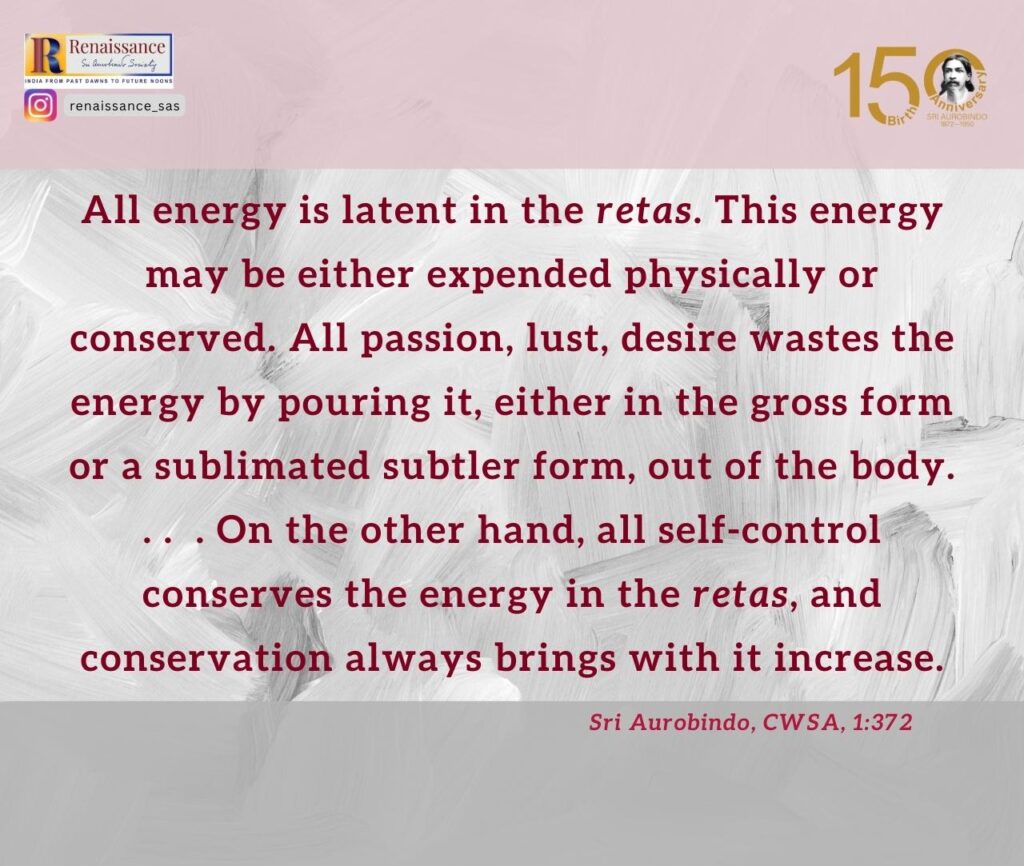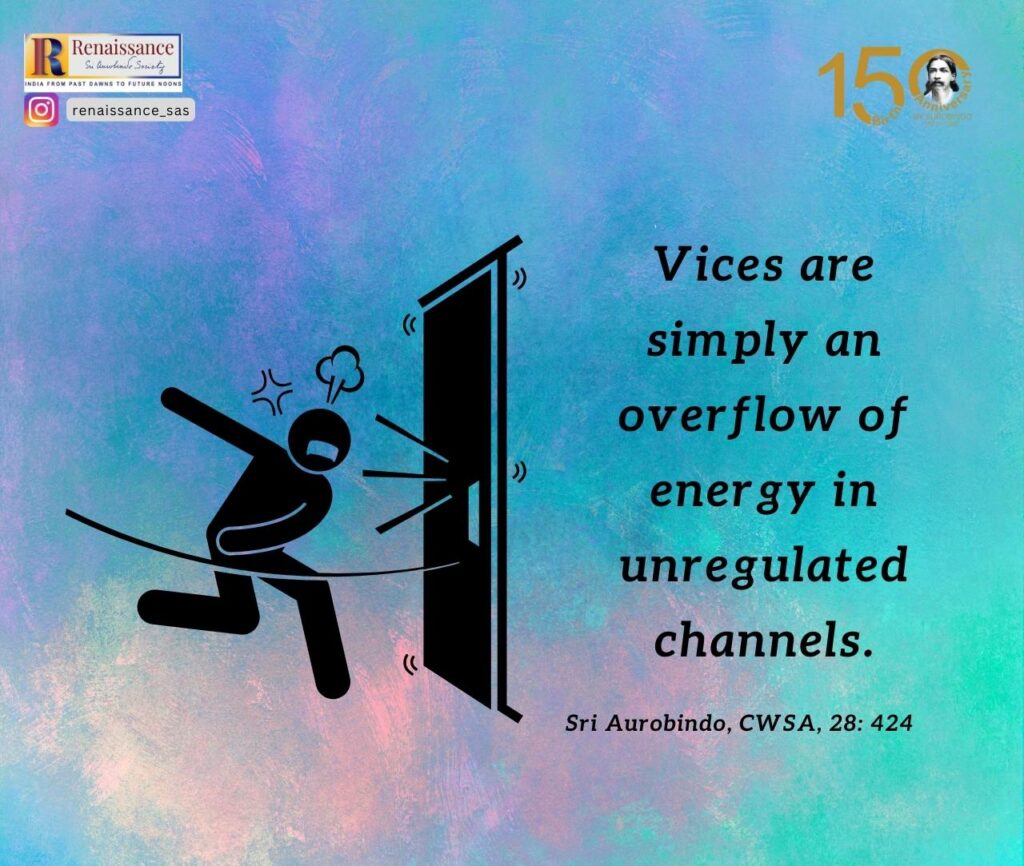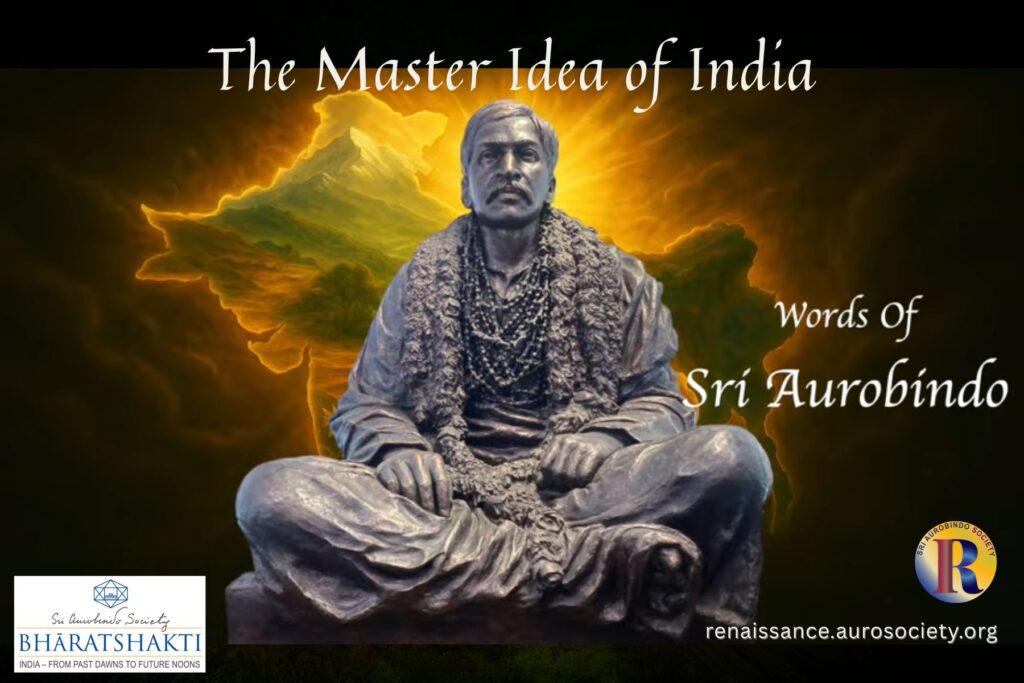Volume III, Issue 10
Author: Beloo Mehra
CONTINUED FROM PART 1

Brahmacharya, a System of Human Energy Management
The practice of brahmacharya is normally understood to mean celibacy or sexual abstinence. It is also often mixed up with the idea of moral purity. But seen in its psychological sense as a system of human energy management, its primary aim is the conservation and transformation of the biological and vital energy stored in the human being into pure intellectual and spiritual energy.
The sex-energy utilised by Nature for the purpose of reproduction is in its real nature a fundamental energy of life. It can be used not for the heightening but for a certain intensification of the vital emotional life; it can be controlled and diverted from the sex-purpose and used for aesthetic and artistic or other creation and productiveness, or preserved for heightening of the intellectual or other energies.
Entirely controlled it can be turned into a force of spiritual energy also. This was well known in ancient India and was described as the conversion of retas into ojas by Brahmacharya. Sex-energy misused turns to disorder and disintegration of the life-energy and its powers.
~ Sri Aurobindo, CWSA, Vol. 31, pp. 504-505
The right practice of brahmacharya depends on the right understanding of the physiological structure of the human receptacle of energy. Indian occult physiology tells us that all human energy has a physical basis and foundation, though the source of all energy is spiritual. This physical basis of human energy exists in the human body as the vital-sexual fluid at the bottom of the spine.
Known as retas, this fluid state of energy potentially contains within it all the other higher luminous states of energy. When not wasted in uncontrolled indulgence of vital passions but conserved and directed upwards by appropriate discipline, this retas energy is progressively transformed into higher states of energy.
* * *

* * *
The practical discipline of brahmacharya thus consists of preventing all wastage and downward gravitation of the vital energy and directing it upwards by giving it a higher orientation. All forms of uncontrolled indulgence of vital desires and passion, especially sexual passion, in thought, feeling and act waste the vital energy. All forms of conscious self-control preserve and increase energy.
Control over sexual impulse is insisted upon, not for any moral reasons but for the conservation of the vital energy and transforming it into a higher form of energy, dynamism and creative force. Sexual impulse is the strongest and the most intense among vital passions, with the highest build-up of vital energy in the urge and maximum wastage of energy in the act. Therefore, its control is especially emphasised. By conservation and transformation the same passion and energy can become a great and potent force for the higher evolution of human beings.
But to achieve the higher aims of brahmacharya, that of attaining self-mastery, increased strength, greater capacity for knowledge and capacity of action, and the ultimate goal of attaining or realising the Self, it is not enough to increase the fund of vital energy.
The increased energy must also be directed upwards by giving it a higher orientation. It should not be wasted in the satisfaction of gross material desires, or in pursuing vital ambitions for power and success. For the progressive transformation of energy as envisioned and practised in the discipline of brahmacharya, the increased fund of energy must be turned toward the realisation of some higher mental, moral or spiritual aim. It should be creatively released in intellectual, artistic, ethical or spiritual pursuits.
The Mother speaks of the significance of brahmacharya for a person dedicated to the path of yoga, committed to make evolutionary progress in consciousness:
Continence is. . . the rule for all those who aspire for progress. But especially for those who want to prepare themselves for the supramental manifestation, this continence must be replaced by a total abstinence, achieved not by coercion and suppression but by a kind of inner alchemy, as a result of which the energies that are normally used in the act of procreation are transmuted into energies for progress and integral transformation.
It is obvious that for the result to be total and truly beneficial, all sexual impulses and desires must be eliminated from the mental and vital consciousness as well as from the physical will. All radical and durable transformation proceeds from within outwards, so that the external transformation is the normal, almost inevitable result of this process.
~ CWM, Vol. 12, p. 54
Sublimation not Suppression
* * *

* * *
The practice of brahmacharya is not about suppression but rather an elimination of an obsession with one’s lower vital impulses. One can never be free of that which is suppressed. Any suppression actually brings back the desire in newer and stronger forms, with redoubled force, and also brings greater frustration, irritability and restlessness of mind.
At the same time, an unhealthy obsession with any desire, particularly sexual desire, brings down the energy, creates dullness, weakens the mind and dampens the overall vigour for life. It hinders one’s mental, intellectual, emotional, psychological and spiritual progress. So, it is important to subdue and channelise the direction of one’s energies to sublimate such lower vital impulses.
The solution lies in widening and heightening one’s consciousness, in regulating one’s energies in directions that help elevate the consciousness and widen the mental vision. Consciously participating in uplifting activities – of the body, mind and emotion – can be of great help. Spending time in nature – walking, gardening, relaxing – is highly recommended to help widen the consciousness.
Regular spiritual practices such as mantra-chanting, japa, worship, prayer, meditation help purify the mind of its perversions and dullness. Rigorous physical exercise and the practice of yogāsana are highly recommended – while the former helps to channel and regulate the physical energy in the body, the latter helps stabilize the mental energy and reduce the restlessness of both the body and mind.
The mind, consisting of thoughts and emotions, is closely related to the breath. Prānayama has been proven to regulate the vital force, the life energy within, and help still the mind.
Physical Education in Ancient India
Given the great value Indian sages placed on brahmacharya as a system of human energy management, it is no wonder that we find a long history of physical education in ancient India, far more ancient than Greece. In his edited volume, Mystery and Excellence of the Human Body, Kireet Joshi gives an excellent summary of the history of physical education in India. He reminds us that the heroes that India gave to herself represent not only great qualities of courage and valour but also of physical strength and excellence.
Read:
Education of the Body in Ancient India – Book Excerpts
Physical education was an integral part of the educational curriculum. The body was not seen as an obstacle rather a basis for spiritual sadhana or practice, a foundation which needs to be perfected and kept in a state of fitness and readiness. Kireet Joshi cites a few examples from the Vedas and Upanishads, where we see that the body, far from being regarded by spiritual seekers as an obstacle, something to be discarded, was considered as a receptacle for strength (bala). Strength was among physical qualities the most praised, he reminds us.
* * *

* * *
During the Vedic and the Upanishadic periods, and even later, we find an emphasis on the pursuit of an integral aim of life, which naturally resulted in an integral education which addressed both the material and spiritual development of the learners. The ancient Sanskrit adage “Shariram adyam khalu dharma sadhanam” (a sound body is the veritable instrument of the pursuit of the ideal law of life) underlined the importance of physical education.
Among the large variety of sciences and arts offered to students, three Upavedas, or sciences, were in some way related to the education of the body: the Upaveda of Rigveda, called Ayurveda (the science and art of sustenance, protection and maintenance of long life); the Upaveda of Yajurveda, called Dhanurveda (science dealing with weapons of war and art of warfare); and the Upaveda of Samaveda, called Gandharvaveda (science of music, singing, dancing and dramatics.
See this flipbook:
Physical Education in Ancient India
Ayurveda made a thorough study of the human body, its different types and needs, and accordingly proposed nutrition and specific exercises and methods for optimum body development, with emphasis on strength and agility. Strength was considered the basis of health and physical development.
Exercise or vyāyāma was considered the surest means of acquiring strength.
Therefore, the knowledge of physical exercises, their nature, types, exact measure of exercise, benefits of exercise and even contraindications and many details about the science of exercise were included in the curriculum elaborated by Ayurveda. Exercise was also used by the ancient physicians as a modality of treatment, like in modern medical science.
For those who studied and practiced Dhanurveda, the science of all weapons of war, it was clearly understood that to be able to develop high proficiency in weapons and movements of war, one required a whole lot of endurance, strength, suppleness, speed, and generally a high level of physical fitness. All these qualities had to be developed through exercises (vyāyāma) and sports.
Kireet Joshi reminds us that such exercises and sports were not exclusively meant for people supposed to join an army or training to become warriors; people from all walks of life were advised to practice them according to their different capabilities. Evidence suggests that a wide range of exercises (vyāyāma), sports and games (krīdā) were popular.
Some of the physical exercises were very strenuous. For instance, Bharasrama consisted in lifting heavy weights made of sandbags of various sizes. Another exercise, still prevalent today, was Stambhasrama, performed on the pillar or with the help of a pillar. The athlete was supposed to exercise by grasping the pillar with his arms and legs and whirling round the pillar. This exercise is now known as mallakhamba.
SEE:
Krīḍā- Making Indian Games Cool!
A conversation with authors of ‘The Games India Plays’ (Video)

CONTINUED IN PART 3
Read Part 1
~ Design: Beloo Mehra



